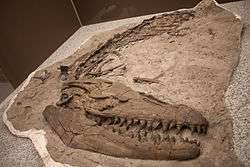Prognathodon
| Prognathodon Temporal range: Late Cretaceous | |
|---|---|
 | |
| Fossil at Royal Tyrrell Museum | |
| Scientific classification | |
| Kingdom: | Animalia |
| Phylum: | Chordata |
| Class: | Reptilia |
| Order: | Squamata |
| Family: | †Mosasauridae |
| Tribe: | †Prognathodontini |
| Genus: | †Prognathodon |
| Species | |
| |
Prognathodon ('forejaw tooth') is an extinct genus of mosasaur squamate reptile.
Description

A medium to large-sized mosasaur, with the skull length reaching 1.5 meters and the total body length up to around 10 meters; the skull was massive and proportionately large.[1] It had protective bony rings surrounding its eye sockets, indicating it lived in deep water. Its teeth are similar to those of some Triassic placodonts, so it may have lived a similar lifestyle, feeding on shellfish, large fish, and sea turtles.
Discovery
Its fossil remains have been found in the U.S.A (South Dakota and Colorado), Canada (Alberta), Belgium, New Zealand, Israel, Morocco, Angola, and The Netherlands. In 1998, an intact fossil skull was found in the Maastricht limestone quarries. Shortly after, it was nicknamed "Bèr", and put on display in the Maastricht Natural History Museum. This specimen was then identified as a Prognathodon, and received the species name Prognathodon saturator.

A very large specimen found in Israel was for some time informally named Oronosaurus, but eventually described as a new species of Prognathodon, P. currii.[2] The recent discovery of 2 nearly complete fossils (one which included flippers) in Alberta, Canada have given scientists new data as previous fossils only contained the remains of the skull. One fossil included stomach contents, consisting of elements pertaining to a sea turtle, tarpon-size and trout-size fishes, and a possible cephalopod.[1]
A new fossil found in 2008 and described in 2013 belonging to a 1.8 m juvenile Prognathodon was found in Jordan's Harrana Site. The fossil was remarkable in that it preserved the outline of the mosasaur's tail fins, revealing that Prognathodon, like Platecarpus and later mosasaurs also had a bilobed tail fluke resembling a downturned shark's tail, the shape of which may have aided the creature in surfacing, as well as attacking prey. The discovery also lends evidence to the theory that later mosasaurs were even more well-adapted to the lifestyle first occupied by the ichthyosaurs.[3]
Classification


Cladogram of mosasaurs and related taxa modified from Aaron R. H. Leblanc, Michael W. Caldwell and Nathalie Bardet, 2012:[4]
| Mosasaurinae |
| |||||||||||||||||||||||||||||||||||||||||||||||||||||||||||||||||||||||||||||||||||||||||||||||||||
| |
Diet
A specimen of Prognathodon kianda, from Bentiaba, Angola, shows gut contents of three other mosasaurs including of its own species.[5] In the 2011 film March of the Dinosaurs, Prognathodon are shown being able to attack, kill, and eat large species of dinosaurs such as Edmontosaurus and Pachyrhinosaurus, though whether this actually occurred is debatable.
References
- 1 2 Konishi, T.; Brinkman, D.; Massare, J. A.; Caldwell, M. W. (2011). "New exceptional specimens of Prognathodon overtoni (Squamata, Mosasauridae) from the upper Campanian of Alberta, Canada, and the systematics and ecology of the genus.". Journal of Vertebrate Paleontology. 31 (5): 1026. doi:10.1080/02724634.2011.601714.
- ↑ Christiansen, P.; Bonde, N. (2002). "A new species of gigantic mosasaur from the Late Cretaceous of Israel". Journal of Vertebrate Paleontology. 22 (3): 629. doi:10.1671/0272-4634(2002)022[0629:ANSOGM]2.0.CO;2.
- ↑ Lindgren, J.; Kaddumi, H. F.; Polcyn, M. J. (2013). "Soft tissue preservation in a fossil marine lizard with a bilobed tail fin". Nature Communications. 4. doi:10.1038/ncomms3423.
- ↑ Aaron R. H. Leblanc, Michael W. Caldwell and Nathalie Bardet (2012). "A new mosasaurine from the Maastrichtian (Upper Cretaceous) phosphates of Morocco and its implications for mosasaurine systematics". Journal of Vertebrate Paleontology. 32 (1): 82–104. doi:10.1080/02724634.2012.624145.
- ↑ Strganac, C., Jacobs L., Polcyn M., Mateus O., Myers T., Araújo R., Fergunson K. M., Gonçalves A. O., Morais M. L., Schulp A. S., da Tavares T. S., & Salminen J. (2014). Geological Setting and Paleoecology of the Upper Cretaceous Bench 19 Marine Vertebrate Bonebed at Bentiaba, Angola. Netherlands Journal of Geosciences. 1-16.